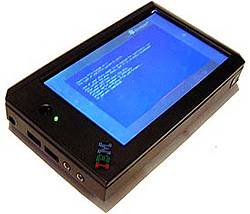 The Mobile Computer Core (MCC) on display by Antelope Technologies of Denver
Colorado is also known as "Meta Pad" technology by its creator - IBM.
The Mobile Computer Core (MCC) on display by Antelope Technologies of Denver
Colorado is also known as "Meta Pad" technology by its creator - IBM.
IBM researchers originally
developed Meta Pad technology to learn how humans interact with computers and to test
out theories on hand held portable computing technologies. Antelope Technologies was born from a
company called Liteye which licensed the Meta Pad Technology for ten years in order to
design an manufacture its own version coined the MCC, or Mobile Computer Core.
The small 3"x5"x0.75" MCC was on display with
a mobile PDA like device, and a docking station. Unlike the solution in development
by OQO, a sushi bar away at the Sea Grille Restaurant, the Antelope is slated
to go into the industrial marketplace as early as September of this year.
The OQO is still very much a prototype and only slated for limited
distribution in Q4, where it can hopefully capture some of the Xmas markets.
Looking
at the two devices of similar size, and comparable applications,
there are few things to take note of. The OQO and MCC "Meta Pad"
are both intended to be mobile computing centers (memory, CPU, and storage are all on
board) that dock with either a special desktop, or laptop station. Where the
two ideas diverge is when the portability comes into play.
The OQO prototypes are always fully accessible, since the touch
sensitive screen allows the user to open up an email or a document at any time.
With Antelope's MCC the computer core is just a small black pack, about
the size of a notebook battery. While it is rather appealing that it doesn't
have to be powered down, or rebooted when it is inserted or removed from an
"accessory" (the term used to describe the notebook casing, or desktop computer)
it is for all intensive purposes completely useless by itself.
This is both a blessing and a curse, depending on the situation I
suppose. The OQO concept is always accessible, and more geared towards consumer
tendencies, but the MCC is a more robust and "shatter-proof" block of technology to work
with. Plus, once it is inserted into the PDA "accessory" it becomes the same
kind of mobile device as the OQO.
According to the company, as cool as this technology
is to geeks around the planet, they will be targeting the vertical
markets (medical, military, industrial sectors). Consumers will have to wait until
next year before they can begin to expect a consumer version.
The MCC specs run as follows;
the unit weighs 9.1 ounces, features a 10GB HDD, 256MB of SDRAM, an 800MHz
TM5800 Crusoe processor (variable voltage of 0.9-1.3V), and can run any
operating system from Windows XP (shown above) to Windows 2000 or even Linux.
Graphics come thanks to an 8MB Silicon Motion Lynx chipset. There is no fan in
the unit since the Crusoe processor doesn't require it.
When docked in the PDA-like
hand held shell shown above, the 1400mAh battery has a lifespan of about 2 hours.
The LCD touch screen supports a resolution of 800x600 and is 5.8" in diameter.
The only ports on the unit are two USB, and two mini Audio jacks. Cost is
expected to be comparable to that of a high-end notebook
computer.
